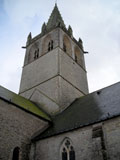Ravenoville
Saint-Côme-du-Mont



Dead Man's Corner
Saint-Côme-du-Mont was one of the major objectives to reach Carentan after capturing and destroying the bridges on Carentan causeway.
Several attempts had been made to take Saint-Côme-du-Mont. On D-Day Captain Samuel Gibbons and 50 soldiers tried and failed to take the town. «The Germans were in the town and they were in strength» (John C. McManus, page 100). During one of the attempts, an American M5 Stuart light Tank was hit by an armor piercing shell, the whole crew was killed instantly, the tank commander's burnt corpse was partially sticking out of the turret. The intersection where this incident occurred became known as «Dead Man's Corner» and is still referred to by that name. The key to really understand this action is to visit Dead Man's Corner Museum. The real attack on Saint-Côme-du-Mont took place at 4.45 am on June 8th, led by General Taylor. Two Battalions of the 506th came in from the North. The 501st's 3rd Battalion and the 1st battalion of the 401st Glider Infantry closed in from the east. A barrage of 75mm and 105mm artillery was laid down by the 65th armored Field Artillery Battalion, and the 101st's own 377th field artillery Battalion.
Wolverton Field
Lt. Col. Bob Wolverton was killed while he was hanging on an apple tree in this field.
The battle was called the «Snafu engagement» (Situation normal all «fall» up) because most of the men were on the brink of exhaustion and the battle did not follow the plan. It was an «uncoordinated (and) clumsy» battle. Most of the attackers remember it as a «blur of random engagements with groups of Germans who were defending buildings, intersections, or hedgerows» (John C. McManus, page 104). The 401st glider infantry's C Company was advancing near the 506 and was delayed for most of the morning because of enemy fire. Finally, after mortaring enemy positions, the column started to move, «almost snail like» (John C. McManus, page 104). Finally, they crossed the N-13, and Dead Man's Corner. As the Americans moved in, the Germans in the German 6th Parachute Regiment retreated to Carentan. The town was in American hands. Now it was on to the Carentan Causeway, which was another objective of Operation Chicago.
In the east, aerial reconnaissance indicated that only a battalion of enemy troops held Carentan. Taylor planned to take the town with a pincer movement. He ordered his men to cross the Douve in two places. To the east, the 327th Glider infantry was supposed to cross the Douve River at Brevands (where Captain Shettle and his men had held the position since D-Day) and push south. Part of the 327th would move southeast and link up with the 29th DI 175th Infantry Regiment west of the Vire, Near Isigny. The rest of the 327th would circle around Carentan from the southeast. The 502nd Parachute Infantry led by Lieutenant Colonel Robert Cole's 3rd Battalion, was to cross the Douve at four bridges, swing southwest of Carentan, and seize Hill 30, the commanding group that controlled movement in and out of the town. At Hill 30, Cole's people were supposed to link up with the 327th. In the meantime, the rest of the 502nd and the entire 506th Parachute Infantry would cross the bridges in Cole's wake and circle around Carentan. The last phase of the operation entailed «entering Carentan and cleaning it out» (John C. McManus, page 106-107). Cole was supposed to begin the attack at 12:00 am on June 10th. But bridge number two had been destroyed and the engineers had been pinned down by 88 mm fire. Lieutenant Gueldaff's patrol paddled across the Douve River, and went down the causeway in single file. At bridge number four they found a Belgian Gate and pried it open, where they could get through one by one. They then came under heavy fire. Gehaudf sent two runners with a message to Cole, «but the runners passed on the wrong message». They told Cole not to go forward because the opposition was too heavy. At the same time Cole got word from battalion that he was to postpone the attack.